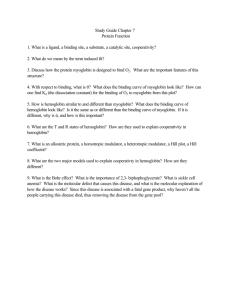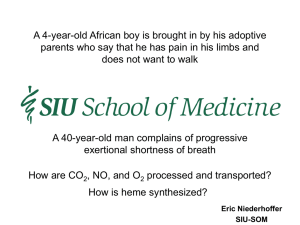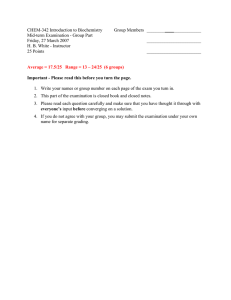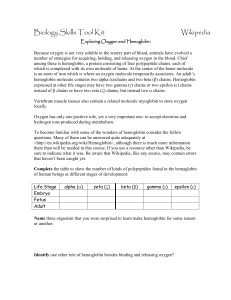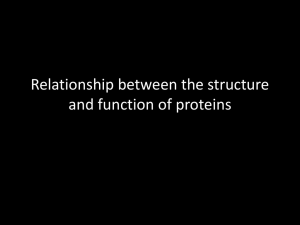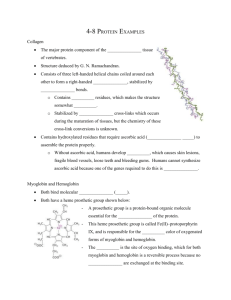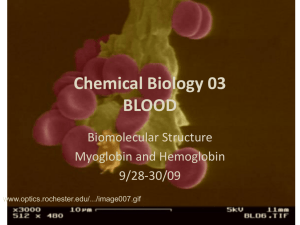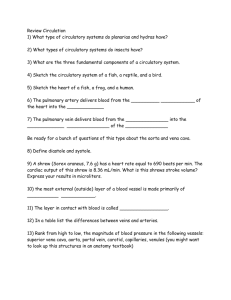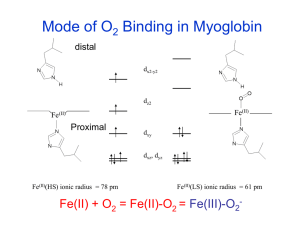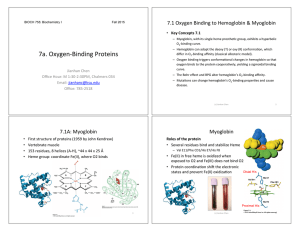Lecture 8: Heme/Non‐Heme Iron Proteins and O Management II Plus a bit of catalysis in Oxygen
advertisement
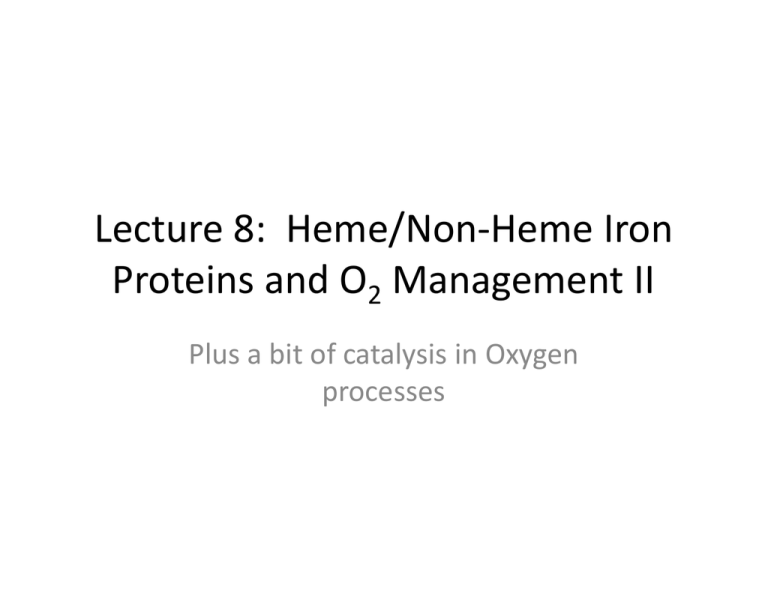
Lecture 8: Heme/Non‐Heme Iron Proteins and O2 Management II Plus a bit of catalysis in Oxygen processes Hemoglobin‐ Key Properties • Ubiquitous O2 transport protein • A globular soluble protein, 2X2 chains (164 kDa) • α and β chains 44% identical • All helical secondary structure (like myoglobin) • αβαβ quaternary structure ¾ α-subunit 141 residues ¾ β-subunit 146 residues • Extensive contacts between subunits ¾ Mix of hydrophobic, H-bond, and ionic interactions ¾ α1β1 (α2β2)- 35 residues, α1β2 (α2β1)- 19 residues First Protein Complex • Hemoglobin. • Two copies each of α & β chains of myoglobin in a complex. • Solved by John Kendrew. Structure of Hemoglobin α2 Heme β1 β2 α1 Inter-subunit contacts Cooperative binding Cooperativity in Binding O2 The sigmoidal shape is a consequence of the 4 subunits of hemoglobin "cooperating" in the binding of O2. • As pO2 increases and [O2] increases, increasing probability that at least 1 subunit has bound O2. Binding of O2 to a subunit INCREASES the probability that empty subunits will be able to bind an O2!! • As pO2 increases even further, the probability that remaining binding sites will have O2 bound increases. • Eventually, a plateau is reached: when most hemoglobins are filled there are few sites left to bind to, so not much increase, even if the pO2 is very high. Structural basis for the allosteric effect Binding of O2 to the Heme Changes the Whole Structure of Hemoglobin R state T state Shifts at the αβ interfaces β chains further apart The T to R State Transition • Binding of O2 causes a series of shifts in all subunits • Change in heme structure upon binding O2 • Since His F8 is covalently attached, all of F helix shifts • Reorganization of helix alters tertiary structure, which in turn alters the quaternary structure- 4 chains behave as a single cooperative structural unit ¾ Changes in packing of hydrophobic side chain ¾ Changes in pairing of charged side chains The change in conformation of Hemoglobin from the T to the R state increases O2 affinity at ALL sites Allosteric Effects • The R or T state can be stabilized by the binding of ligands other than O2. 1. H+. Lower pH favors the T state which causes Hb to release bound O2. This is known as the Bohr Effect. 2. CO2. Release of CO2 lowers pH via conversion to HCO3-: CO2 + H2O ↔ HCO3- + H+. Reinforces Bohr Effect Allosteric Effects 3. Bisphosphoglycerate (BPG). Regulation of activity via binding more strongly to T state, helps to release O2. Increase in levels of BPG helps adaptation to high altitude- faster than making more hemoglobin. Towards a More Complete Picture Model for disucssion HEMOGLOBIN at the pH (~7.6) found in the lungs. HEMOGLOBIN at the pH (~7.2) found in peripheral tissues. MYOGLOBIN in muscle (a peripheral tissue). Path of O2 Flow 1. O2 diffuses from the alveoli of the lungs into the capillaries of the bloodstream then into the red blood cells 2. In the red blood cells, O2 binds to hemoglobin. 3. In parallel, CO2 diffuses from blood into the alveoli. 4. The lower concentration of dissolved CO2 in the blood causes higher pH (~7.6) in lungs than in the peripheral tissues (~pH 7.2) where CO2 is being actively released. A. High pO2 / high pH Why O2 Transport Works 5. Red blood cells (containing O2-hemoglobin) carried to the peripheral tissues. B. pO2 decreases because O2 USED by the tissues. C. Blood plasma becomes more acidic (lower pH) because CO2 is released. The combination of lower pO2 and pH in the peripheral tissues causes a large decrease in O2 saturation. O2 is released by hemoglobin!!!! Note: changes in pO2 and pH are small! Why Myoglobin in Muscle? • Under resting conditions, O2 saturation is at point X on the green curve • Small changes in pO2 and pH have very little effect on saturation • During extremely vigorous exercise, heart pumps blood fast and breathing is rapid to increase the intake of O2 . Also, pH is lowered. • Eventually, transport not fast enough to meet needs, i.e. pO2 lowered because O2 is used faster than it can be replenished. [Hemoglobin now no help!] • Under extreme conditions, shift from point X to Y: saturation of the myoglobin is lowered = release of O2. Defects from Hemoglobin Mutations 1. Weakened heme binding. 2. Disruption of secondary structure. 3. Disruption of quaternary structure. 4. Defective oxygen transfer. 5. Altered affinity for oxygen. 6. Oxidation of Fe(II) to Fe(III). 7. Aggregation in the T state (Hemoglobin S). Sickle cell anemia results from aggregation of Hb into insoluble fibers causing misshapen blood cells that cannot pass through capillaries and block blood flow to tissues. Heme Proteins II: Dioxygen activation: Hydroperoxidases Assigned readings: Bertini Book, Chapter XI: XI1, XI3 Hemerythrin Hemocyanin and Oxyhemocyanin Oxyhemocyanin Models.
